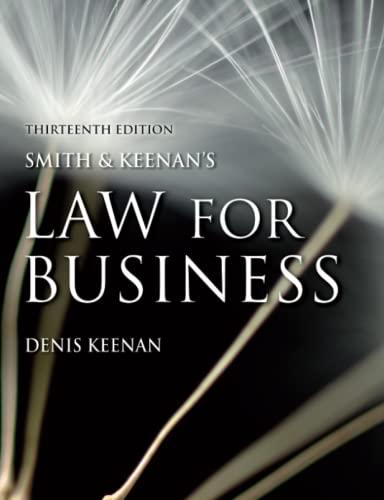Question
Scenario 1: OFFENDER A Offender A is a 20-year-old white male who is a senior business management major at Clayton State University. He is currently
Scenario 1:
OFFENDER A Offender A is a 20-year-old white male who is a senior business management major at Clayton State University. He is currently completing an internship with a prominent financial investment firm and has been accepted to the Harvard graduate school of business where he plans to earn a Master's of Business Administration (MBA). Throughout his college career, he has been an active member of his fraternity volunteering several times to help those in need including the poor, abused children, and the elderly. He has also held a part-time job as a banker. Finally, offender A has maintained an academic scholarship during this college tenure. In fact, his grade point average (GPA) has been 3.70 or higher. Recently, offender A was convicted of 2nd degree aggravated assault (2nd degree indicates a serious offense that caused physical harm) stemming from a bar fight. Eyewitnesses maintain that offender A severely beat and kicked a victim. Indeed, the victim suffered broken ribs, a broken nose, five stitches to heal a cut on his face, and a three day stay in the hospital. The offender contends he was helping a fellow fraternity brother who as being harassed by members of a rival fraternity. During the trial it was revealed that offender A had a prior conviction for shoplifting ($50 worth of clothing) and a driving under the influence (DUI) when he was 18 years old.
Scenario 2:
OFFENDER B Offender B is a 21-year-old Hispanic male who is an acknowledged gang member. He is currently unemployed and over the past five years has not held a job longer than eight months. Most of the jobs he finds are temporary positions in part because he does not have a high school diploma. By his own admission, the offender dropped out of school because he had difficulty understanding and speaking English and believes the lack of education coupled with language barriers have prevented him from finding a permanent, stable job. Recently, offender B was convicted of 2nd degree aggravated assault for pistol whipping and threatening a victim with a handgun. The offender slapped the victim several times with the barrel of the gun leaving one minor bruise on the victim's face. The offender contends that the victim sexually harassed his sister. Offender B maintains that his cultural norms require men to protect their family and loved ones and he was simply fulfilling his cultural duties. The offender has no prior convictions but has been arrested four times for various charges including vandalism, loitering, motor vehicle theft, and drug distribution. However, none of the arrests have resulted in a conviction primarily because of a lack of physical evidence or eyewitness testimony.
QUESTION 2: PRESUMPTIVE OR SENTENCING GUIDELINE STRUCTURE Assume the offenders reside in a state that uses a presumptive or sentencing guideline structure that base decisions primarily on legal factors. As such, the punishments might look like Offender A Offender B Offense seriousness level: 15 points o 8 points - 2nd degree aggravated assault conviction o 2 points - Offense involved the use of personal weapons (fist and feet) o 5 points - Victim suffered major physical injuries (broken bone, gash, hospital stay) Offense seriousness level: 13 points o 8 points - 2nd degree aggravated assault conviction o 4 points - Offense involved hitting and threatening a victim with a handgun o 1 point - Victim suffered one minor bruise to the face (no hospital attention) Criminal history: 3 points o 2 points - Offender has a prior conviction for driving under the influence o 1 point - Offender has a prior conviction for shoplifting (misdemeanor) Criminal history: 1 point o 0 points - No prior convictions o 1 point - Gang affiliation Sentence: o 36 months (3 years) to 60 months (5 years) o No possibility of parole Sentence: o 12 months (1 year) to 36 months (3 years) o No possibility of parole For this question, please answer the following: o Compare your sentence decisions for question 1 to the outcomes in question 2. Did the presumptive sentencing structure or sentencing guideline produce a different sentence outcome for offender A and B? If so, was your punishment more lenient (fewer years) or harsher (more years)? Also, discuss why you think there was a similarity or difference between the two outcomes. o In comparing the outcomes under indeterminate (question #1) and sentencing guidelines (question #2), which model would you support? Explain
Step by Step Solution
There are 3 Steps involved in it
Step: 1

Get Instant Access to Expert-Tailored Solutions
See step-by-step solutions with expert insights and AI powered tools for academic success
Step: 2

Step: 3

Ace Your Homework with AI
Get the answers you need in no time with our AI-driven, step-by-step assistance
Get Started


